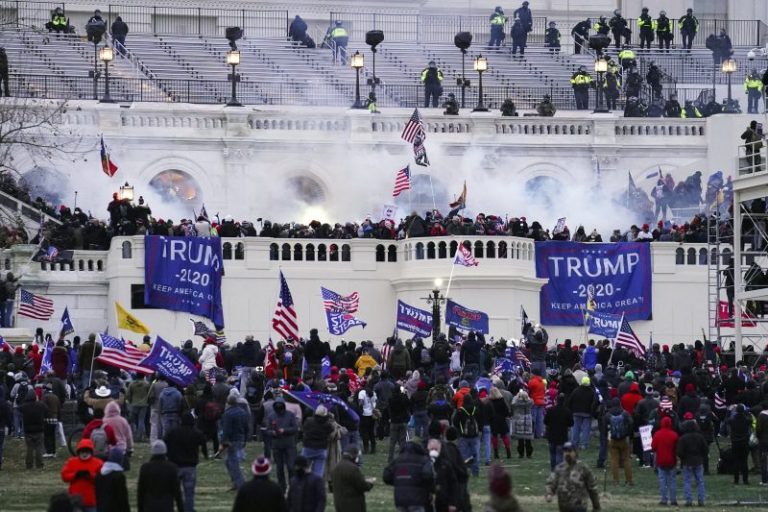It has been some 25 months since supporters of Donald Trump stormed the U.S. Capitol. Trump was later impeached for allegedly inciting the mob, with a historic number of Republicans voting to convict, though the Senate acquitted him. And many of those arrested for rioting said Trump’s suggestive language ahead of that date amounted to a call to arms.
Trump has shown little remorse and no signs of self-reflection about what happened that day. In fact, he’s making and promoting the same kind of references to political violence that preceded Jan. 6.
Perhaps the most pronounced recent example came Tuesday. On his Truth Social platform, Trump shared the message of a user actively encouraging physical violence on his behalf.
Discussing a hypothetical effort to disqualify Trump from office, the user said anyone behind such an effort “will have to figure out how to fight 80,000,000 + it’s not going to happen again.”
“People my age and old will physically fight for him this time,” the user said. “What we got to lose ? I’ll donate the rest of my time here on this planet to do it. And I know many many others who feel the same. They got my 6 and we Are Locked and LOADED.”
Trump decided this was a message that needed to be shared with his supporters.
Unlike many of Trump’s previous allusions to political violence, this one contains no real ambiguity or dual meaning that could be exploited for plausible deniability. It was a straight-up assurance that Trump supporters will “physically” fight for him, en masse.
This is only the latest instance in which Trump has gestured in this direction. Using Truth Social, in recent months he has upped his amplification of messages related to QAnon, a conspiracy theory that the FBI has linked to the threat of extremist violence and that was embraced by many Jan. 6 rioters.
And just after the raid of Mar-a-Lago in mid-August, Trump warned that “terrible things are going to happen” if people become enraged at his treatment.
Trump at the time layered his comments with a purported offer to do what he could to help lower the “temperature,” but even his allies at Fox News were skeptical that was really his intent. And Trump’s comments since then certainly indicate that skepticism was warranted.
Indeed, later that month, Trump ally Sen. Lindsey O. Graham (R-S.C.) predicted “riots in the streets” if the former president were prosecuted for failing to return classified documents. Trump promoted the interview on Truth Social without comment. (Graham later tried to walk this back, saying, “I reject violence.”)
Then, in late September, Trump slipped some chilling words into one of his regular social media attacks on Senate Minority Leader Mitch McConnell (R-Ky.), saying McConnell “has a DEATH WISH.” The conservative Wall Street Journal editorial board summed the situation up thusly: “Mr. Trump’s apologists claim he merely meant Mr. McConnell has a political death wish, but that isn’t what he wrote. It’s all too easy to imagine some fanatic taking Mr. Trump seriously and literally, and attempting to kill Mr. McConnell.”
Trump employed and shared such suggestive rhetoric early and often in his political career. A federal judge in 2017 found that he might have incited violence at one of his rallies. In one 25-hour period in mid-2020, Trump said, of violent racial-justice demonstrations, “When the looting starts, the shooting starts,” and promoted video of an ally saying, “The only good Democrat is a dead Democrat.”
(Incidentally, that ally was later convicted of his role in the Jan. 6 riot and then became the first U.S. official in 150 years to be constitutionally disqualified from office for engaging in insurrection.)
These kinds of comments have drawn criticism — and warnings about their dangers — before. They felt freshly relevant in the aftermath of the insurrection, which furnished stark evidence that certain people take such Trump comments as literally and as seriously as some observers feared.
And the weight of such rhetoric was felt again after it ramped up in the wake of the Mar-a-Lago search: The FBI reported increased threats against its agents, and an armed Trump supporter and avid Truth Social user tried breaking into an FBI field office in Cincinnati, before being killed in a shootout.
There is now no denying that such language, even if you somehow regard Trump’s intentions as innocent, can lead to a very dark place.
And now, the Jan. 6 committee’s investigation has offered real evidence that Trump might have seen the political utility of violence and the threat of violence that day, when he resisted calling for peace and later expressed “love” for supporters who stormed the Capitol.
Despite the supposed olive branch he offered in mid-August, it has become abundantly clear that Trump views his supporters’ willingness to get violent as something to be proud of, and potentially as leverage.
Likely because of all its precedents, what happened Tuesday has gone largely unremarked-upon in news coverage. But it was a striking moment: a supporter offering the kind of sentiment that many acted on in real life on Jan. 6 — and Trump deciding to share that with others primed into similar beliefs about the nefarious people trying to take him down.

